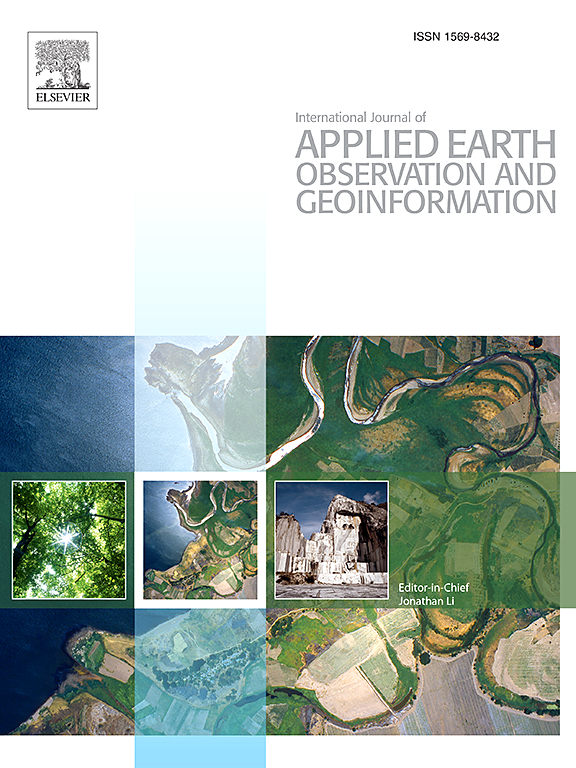Geospatial impact evaluation of a low-cost agricultural intervention for enhancing environmental resilience
IF 8.6
Q1 REMOTE SENSING
International journal of applied earth observation and geoinformation : ITC journal
Pub Date : 2025-06-10
DOI:10.1016/j.jag.2025.104657
引用次数: 0
Abstract
Land degradation poses a significant threat to ecosystems and livelihoods, particularly in disaster-prone regions. In these settings, the promotion of certain agricultural practices with economic incentives, such as sugarcane (Saccharum officinarum) farming, offers a potential solution for enhancing economic stability and mitigating environmental degradation. Despite its promise, the effectiveness of sugarcane as an agricultural intervention remains understudied, especially regarding its environmental benefits. Our study evaluates the impact of sugarcane cultivation in western Nepal, a region highly vulnerable to soil erosion and riverbank degradation due to the presence of flood-prone landscapes. We conducted a geospatial impact evaluation (GIE), which integrated remote sensing data and econometric techniques, including optimal full matching (OFM) and difference-in-differences (DID). We assessed the causal impact of a program promoting sugarcane farming on its adoption and environmental outcomes, measured using multi-temporal satellite imagery, crop phenology, and clustering algorithms, along with machine learning and visual interpretation methods. Our results show that sugarcane adoption increased significantly in both treated and spillover communities, highlighting its potential as a sustainable agricultural practice. However, while uptake was evident, the expected environmental outcomes, such as soil erosion control and riverbank stabilization, did not materialize. This study demonstrates the potential of GIE in evaluating low-cost interventions for sustainable development and provides insights into the role of sugarcane cultivation in promoting climate resilience. The findings underscore the need for complementary interventions and extended timeframes to realize long-term environmental benefits, contributing valuable evidence for policymakers and development practitioners.
提高环境恢复力的低成本农业干预措施的地理空间影响评价
土地退化对生态系统和生计构成重大威胁,特别是在灾害易发地区。在这些情况下,以经济奖励促进某些农业做法,例如种植甘蔗,为加强经济稳定和减轻环境退化提供了一个潜在的解决办法。尽管前景看好,但甘蔗作为一种农业干预手段的有效性仍未得到充分研究,尤其是在其环境效益方面。我们的研究评估了尼泊尔西部甘蔗种植的影响,该地区由于存在易受洪水影响的景观,极易受到土壤侵蚀和河岸退化的影响。我们进行了地理空间影响评估(GIE),该评估综合了遥感数据和计量经济学技术,包括最优完全匹配(OFM)和差中差(DID)。我们利用多时相卫星图像、作物物候学和聚类算法,以及机器学习和视觉解释方法,评估了促进甘蔗种植计划对其采用率和环境结果的因果影响。我们的研究结果表明,甘蔗的采用率在经过处理和外溢的社区都显著增加,凸显了其作为可持续农业实践的潜力。然而,虽然吸收是明显的,但预期的环境结果,如土壤侵蚀控制和河岸稳定,并没有实现。这项研究证明了全球环境变化在评估可持续发展的低成本干预措施方面的潜力,并为甘蔗种植在促进气候适应能力方面的作用提供了见解。研究结果强调需要采取补充性干预措施和延长时间框架来实现长期环境效益,为政策制定者和发展实践者提供了宝贵的证据。
本文章由计算机程序翻译,如有差异,请以英文原文为准。
求助全文
约1分钟内获得全文
求助全文
来源期刊

International journal of applied earth observation and geoinformation : ITC journal
Global and Planetary Change, Management, Monitoring, Policy and Law, Earth-Surface Processes, Computers in Earth Sciences
CiteScore
12.00
自引率
0.00%
发文量
0
审稿时长
77 days
期刊介绍:
The International Journal of Applied Earth Observation and Geoinformation publishes original papers that utilize earth observation data for natural resource and environmental inventory and management. These data primarily originate from remote sensing platforms, including satellites and aircraft, supplemented by surface and subsurface measurements. Addressing natural resources such as forests, agricultural land, soils, and water, as well as environmental concerns like biodiversity, land degradation, and hazards, the journal explores conceptual and data-driven approaches. It covers geoinformation themes like capturing, databasing, visualization, interpretation, data quality, and spatial uncertainty.
 求助内容:
求助内容: 应助结果提醒方式:
应助结果提醒方式:


